Budgie Body Colors
Mauve, Cobalt, Violet...?
Budgie body colors, where should we start? How about with your basic Light Green Normal budgie. This colour is basically made up of yellow and blue as described on Budgie Colours. The term 'body colour' refers only to the green, blue or grey color of the budgies body, not to the wing or face colour. The face (also called mask) colour is often referred to as the base colour i.e. white base or yellow base. The wing colours are covered at Budgie Varieties.
We can divide budgie body colours into two groups, the Green Series (all those with yellow present) and the Blue Series (all those without yellow). There are three varieties - Yellowface 1 and 2, and Goldenface - that have reduced yellow but that will be covered on the Budgie Varieties section. Lets just stick to plain old blue or green body colour for now.
There are three effects that we should cover before we discuss the individual colours; the Dark Factor, the Grey and the Violet.
Dark Factor - the Dark Factor creates three different shades. Each budgie can carry two non-Dark Factor gene, one Dark with one non-Dark Factor gene, or two Dark Factor genes. Within the Green Series this results in the Light Green (no Dark Factor, this is the wild type), Dark Green (one Dark Factor) and Olive (two Dark Factor). Likewise in the Blue Series you get Skyblue (no Dark Factor), Cobalt (one Dark Factor) and Mauve (two Dark Factors).
Grey - this gene has the effect of making a blue budgie look Grey, and a green budgie into what is called a Grey Green. It effectively washes a grey shade over the base colour of the bird. This means a Skyblue bird becomes a Light Grey, a Cobalt becomes a Medium Grey and a Mauve a Dark Grey, with the same in the Grey Greens. It can be difficult to tell the shades apart though so mostly they are just called Grey or Grey Green.
Violet - the Violet gene has a darkening and enriching effect on budgie body colours. It can be present in both Green and Blue Series birds, but is most obvious in the Blue Series.
Slate - the Slate is a less common colour so you are not likely to come across it unless you are hunting for it. It has a similar effect to Violet, a darkening and enriching effect, but rather than a violet hue, it produces a blue/grey slate shade. It can be present on any colour bird, however it really only visual on the blue birds, and is most obvious when on a Skyblue bird. When combined with Grey it produces a nice, very dark bird. There are a couple of Slate pictures on the right, a Slate Violet chick and a Slate Skyblue cock.
So without further ado let’s look at the individual shades! I am going to talk only about the budgie body colours, we can talk about variations in markings on another page.
The Green Series
Light green - this is the original color of the budgie with no dark factors present, just a lovely bright grass green.
 Dark green – the intermediate shade of green with one dark factor. It is darker and lacks the iridescence of light green. It can be tricky to show the difference in photos, in reality they are quite different side by side.
Dark green – the intermediate shade of green with one dark factor. It is darker and lacks the iridescence of light green. It can be tricky to show the difference in photos, in reality they are quite different side by side.

 Olive – the darkest shade of green with two dark factors. It is almost a muddy green shade. This color can look a lot like Grey Green. They can be distinguished by the color of their cheek patches (violet blue in Olive and greyish blue in Grey Green birds) and long tail feathers (dark blue in Olive and black in Grey Green).
Olive – the darkest shade of green with two dark factors. It is almost a muddy green shade. This color can look a lot like Grey Green. They can be distinguished by the color of their cheek patches (violet blue in Olive and greyish blue in Grey Green birds) and long tail feathers (dark blue in Olive and black in Grey Green).
 Grey green – the grey gene washes over the green to make a color similar to Olive but with the different cheek patch and long tail feathers as described above. Grey Greens can be light, medium or dark depending on how many dark factors are present.
Grey green – the grey gene washes over the green to make a color similar to Olive but with the different cheek patch and long tail feathers as described above. Grey Greens can be light, medium or dark depending on how many dark factors are present.
The budgie on the right is a chick and therefore a paler shade, once it moults it will darken a little and become a stronger color, more like the Olive above. If you compare its cheek patch with those of the Olive you will see the difference as described above. The budgie on the left has silverish cheek patches due to it also being of the Spangle variety, which will be discussed on another page. She is just here to give another example of a light Grey Green shade.
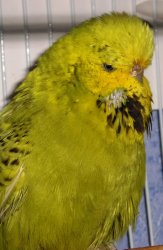 |
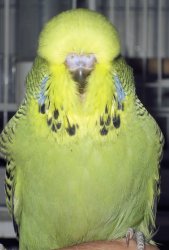 |
 Violet – the violet gene behaves like the grey gene in that it washes over green base color and alters it. The effect is to darken and enrich the shade of green. This makes, for example, a Light Green bird with the violet gene look similar to a Dark Green. The color palette is a violet Dark Green.
Violet – the violet gene behaves like the grey gene in that it washes over green base color and alters it. The effect is to darken and enrich the shade of green. This makes, for example, a Light Green bird with the violet gene look similar to a Dark Green. The color palette is a violet Dark Green.
 The Blue Series
The Blue Series
Skyblue – the lightest shade of blue, with no dark factors. It is basically a light green bird with the yellow removed, leaving a lovely bright iridescent pale skyblue.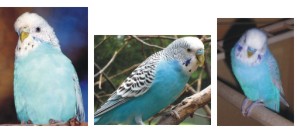
 Cobalt – the medium shade of blue with one dark factor. Cobalt desribes this colour well. It is darker than Skyblue and has lost the iridescence.
Cobalt – the medium shade of blue with one dark factor. Cobalt desribes this colour well. It is darker than Skyblue and has lost the iridescence.
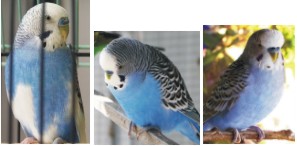
 Mauve – mauve is the darkest blue with two dark factors. It can look muddy and greyish but is much bluer than a grey. If in doubt remember that a grey has grey cheek patches and a black tail whilst mauve has violet cheek patches and a blue tail.
Mauve – mauve is the darkest blue with two dark factors. It can look muddy and greyish but is much bluer than a grey. If in doubt remember that a grey has grey cheek patches and a black tail whilst mauve has violet cheek patches and a blue tail.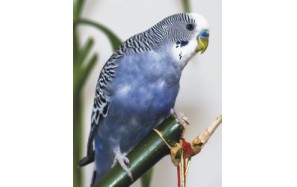
 Grey – the grey gene causes a grey wash over the blue body colour resulting in a grey bird. Remember that the grey gene also changes the cheek patches to grey and the tail feathers to black. Like the grey greens greys come in light, medium and dark depending on what shade of blue it is covering.
Grey – the grey gene causes a grey wash over the blue body colour resulting in a grey bird. Remember that the grey gene also changes the cheek patches to grey and the tail feathers to black. Like the grey greens greys come in light, medium and dark depending on what shade of blue it is covering.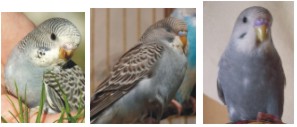
 Violet – The violet gene works by causing a darkening and enriching of the birds base colour. It can, for example, make a skyblue appear cobalt. My first ever violet was a violet skyblue that I thought was cobalt. However after a few matings I realised she wasn't, and on inspection I noticed that above her wings in the neck region her color was a richer more violet than the cobalt elsewhere. This can sometimes provide a clue to the presence of violet. The most beautiful of these is the violet cobalt, which shows the strong violet colour and is therefore often called a visual violet. The lovely bird on the right is a visual violet, they are often not that strongly violet, more of a rich cobalt.
Violet – The violet gene works by causing a darkening and enriching of the birds base colour. It can, for example, make a skyblue appear cobalt. My first ever violet was a violet skyblue that I thought was cobalt. However after a few matings I realised she wasn't, and on inspection I noticed that above her wings in the neck region her color was a richer more violet than the cobalt elsewhere. This can sometimes provide a clue to the presence of violet. The most beautiful of these is the violet cobalt, which shows the strong violet colour and is therefore often called a visual violet. The lovely bird on the right is a visual violet, they are often not that strongly violet, more of a rich cobalt.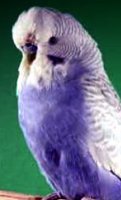
 These are the basic budgie body colors, as they are found when not altered by the mutations that have created the many varieties that budgies come in. We will cover these (opaline, spange, ino, pieds etc) in another page as they work separately from the budgie body color.
These are the basic budgie body colors, as they are found when not altered by the mutations that have created the many varieties that budgies come in. We will cover these (opaline, spange, ino, pieds etc) in another page as they work separately from the budgie body color.
